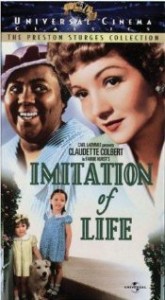Page to Screen: Imitation of Life (1934)
Yesterday I reviewed “Why Are All the Black Kids Sitting Together in the Cafeteria?” by Beverly Daniel Tatum. In the chapter called Identity Development in Multiracial Families she writes that, “The stereotype of the ‘tragic mulatto’ – as portrayed in the classic film Imitation of Life, for example – is one of marginality and maladjustment.” I thought it would be interesting to watch the film to gain a better understanding of what she was writing about.
 In doing some further research, I discovered that the 1934 version of the film is considered a ground breaking film about race for the time and is actually based on the novel Imitation of Life by Fannie Hurst. The film was remade in 1959 and there is also a book called Born to Be Hurt: The Untold Story of Imitation of Life by Sam Staggs that is a behind the scenes look at the filming of the 1959 movie. I’d like to read those books at some point but today I’ll be focusing on the 1934 version of the movie and then tomorrow I’ll discuss the 1959 version. I was going to do both today but my post ended up to be way longer than I anticipated just writing about the first movie!
In doing some further research, I discovered that the 1934 version of the film is considered a ground breaking film about race for the time and is actually based on the novel Imitation of Life by Fannie Hurst. The film was remade in 1959 and there is also a book called Born to Be Hurt: The Untold Story of Imitation of Life by Sam Staggs that is a behind the scenes look at the filming of the 1959 movie. I’d like to read those books at some point but today I’ll be focusing on the 1934 version of the movie and then tomorrow I’ll discuss the 1959 version. I was going to do both today but my post ended up to be way longer than I anticipated just writing about the first movie!
The 1934 movie stars Claudette Colbert as Bea Pullman, a widow who is struggling to make ends meet after taking over her late husband’s maple syrup business. One day Delilah Johnson (Louise Beavers) shows up at her door with her young daughter Peola looking for a job as a housekeeper. She offers to work for Bea for no pay, just room and board. One day, Delilah makes delicious pancakes for Bea, using her secret family recipe. Bea loves the pancakes so much, she opens a pancake house to sell them. Eventually, she and Delilah go into business selling pancake mix and they become wealthy.
While all this is going on, Peola is struggling. Even though her mother is a dark skinned black person, Peola is light enough that she can pass for white. (Delilah tells Bea at the beginning of the movie that Peola’s father is very light too.) Peola is ashamed of being black and passes for white whenver she can. Of course, she is outed whenever her mother shows up unexpectedly somewhere, which happens quite often. She grows to resent her mother because of this.
It’s interesting to view this film through the lens of today’s world. Delilah is very much the stereotypical Mammy character. She wants nothing more than to serve Bea and take care of her. Even after Bea gives her a twenty percent interest in the business, Delilah tells Bea to just keep all her earnings for her. She doesn’t want her own home or car, she just wants to keep living with Bea. (And why does she only get a twenty percent interest? It’s her pancake recipe and her face on the box!) When Bea comments that Peola is smarter than Bea’s daughter Jessie, Delilah says something to the effect of we’re all born smart, we get dumb later on. It was somewhat unclear to me if she’s talking about the black race or the human race but it sounded like she was just speaking about black people.
There are just a handful of scenes that are focused on Peola and her struggles. In this film the main plot is Bea’s business and her romance with Steve Archer (Warren William). The kissing scenes in this movie were hilarious. They didn’t pucker up so much as just smash closed mouths together. Is that how everyone kissed back then? My husband and I tried to kiss that way for fun after watching this movie and were cracking up. But I digress…
I didn’t think that Peola’s subplot had that much depth. She talks about wanting to be white but doesn’t talk about why. Perhaps that would have been too much for a film to delve into in the 1930s. When Peola and Jessie are in elementary school, Peola comes home from school crying because Jessie called her black. Bea asks Jessie why she would say such a horrible thing and gives her a stern talking to. I thought that was really interesting that “black” would be considered an insult or slur back then but “colored” was not.
Fredi Washington, the actress who played Peola as an adult, was a green-eyed, light skinned black woman. Ironically, she was encouraged to pass for white by studio heads so she could be cast in more roles but unlike Peola, she refused to pass. She was a fantastic actress but unfortunately there weren’t many roles for a light-skinned black person back then. For some of her roles she had to wear makeup to darken her appearance.
This was an eye-opening film for me and I think anyone interested in the history of race relations in the United States would find it very interesting to watch. If you are interested in a thoroughly detailed analysis of the film, check out this article I found during my research about the film.
Buy this film at:
Amazon Instant Video





Pingback: Chaos Is A Friend of Mine » Blog Archive » Page to Screen: Imitation of Life (1959)()